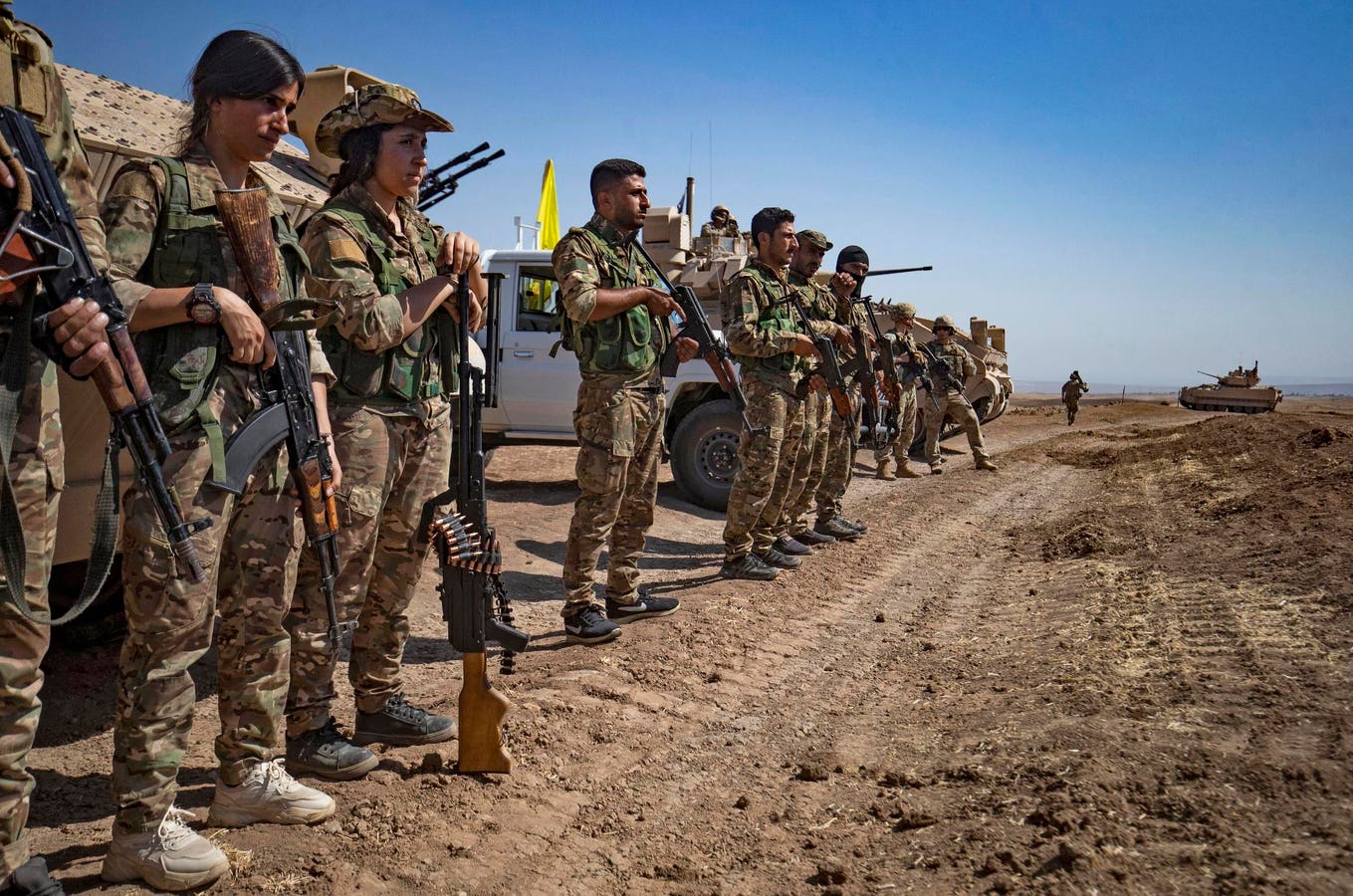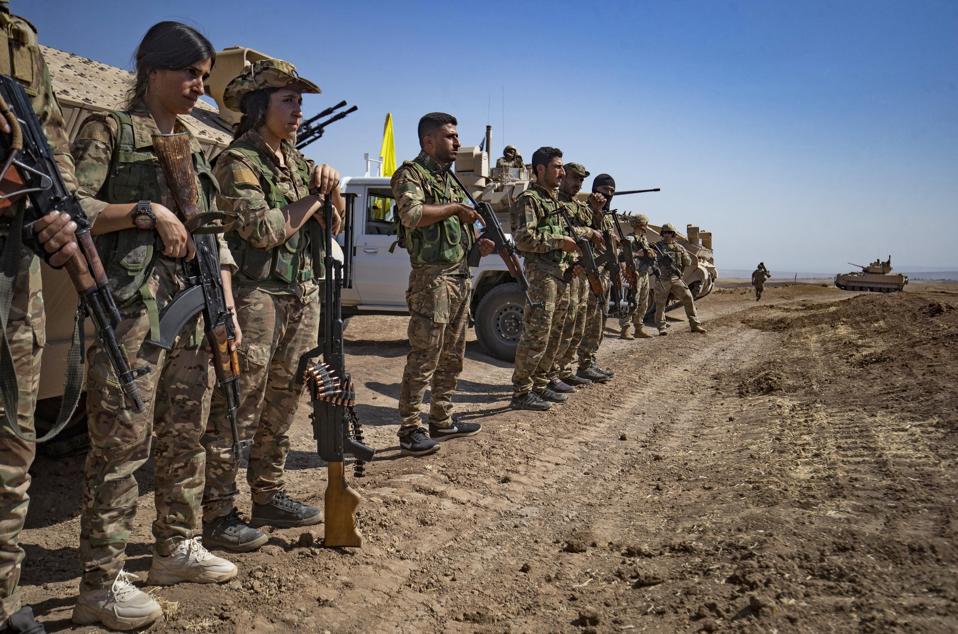Fighters of the Syrian Democratic Forces (SDF) attend a joint military exercise with forces of the US-led “Combined Joint Task Force-Operation Inherent Resolve” coalition against the Islamic State (IS) group in the countryside of the town of al-Malikiya (Derik in Kurdish) in Syria’s northeastern Hasakah province on September 7, 2022. (Photo by Delil SOULEIMAN / AFP) (Photo by DELIL SOULEIMAN/AFP via Getty Images)
AFP via Getty Images
The U.S.-backed Kurdish-led Syrian Democratic Forces group has had a tough week. On July 31, Islamic State, IS or ISIS, militants attacked one of the group’s checkpoints in the eastern Deir ez-Zour province, killing five of their troops. Furthermore, SDF fighters in the north clashed twice with government-affiliated forces in Aleppo province, specifically Manbij on Saturday and Deir Hafer early Monday.
These incidents are reminders that the SDF remains the foremost force preventing any ISIS resurgence in Syria, and that attacks against it, intending to coerce it into folding under the new central government in Damascus, will only destabilize an already fragile state.
Unsurprisingly, the SDF and government forces traded blame over who was responsible for these clashes. The Syrian defense ministry claimed the Manbij incident started after the SDF targeted army outposts with rocket fire, injuring four government troops and three civilians. The SDF counters that it was responding to “unprovoked artillery assault targeting civilian-populated areas.”
The SDF claimed Monday’s incident started after government-affiliated fighters targeted four of its positions, resulting in 20 minutes of clashes. The group declared that Damascus bears complete responsibility for the attack and reaffirmed its right to respond to such provocations.
The Kurdish-led group faced repeated attacks against its forces and Kurdish civilians in December as the former regime of Bashar al-Assad collapsed and early this year from militants operating under the banner of the Turkish-backed self-styled Syrian National Army. These militias repeatedly skirmished with the SDF along the Euphrates River until a ceasefire came into effect earlier this year. These same groups later carried out many of the grisly sectarian massacres of Alawite civilians along Syria’s coastal Latakia province in March, which killed at least 1,479, mostly civilians, following attacks by remnants of the former Assad regime.
Consequently, with many of these same militants operating within or alongside pro-government forces, it’s hardly surprising that misunderstandings or continued lack of coordination, or government control over newly-integrated militias, could lead to clashes like these recent ones.
Such clashes will no doubt complicate the new Syrian government’s goal of absorbing the SDF into the new army. SDF leader Mazloum Abdi and Syrian interim president Ahmed al-Sharaa signed an integration agreement on Mar. 10, and the SDF has repeatedly affirmed its commitment to Syrian sovereignty, territorial integrity, and eventual integration of armed groups under state control. However, Damascus continually demands that the SDF disband and its troops join the new army as individuals. At the same time, the SDF insists it integrate into the new Syrian army as a bloc or in units.
Then there’s the July events in the southern city of Sweida, which saw the tribal fighters mobilized alongside government forces and intervening in local clashes between Druze and Bedouin forces. Sharaa attempted to use the clashes as an opportunity to assert complete government control over the Druze region but ended up incurring airstrikes from Israel, which had repeatedly warned it would militarily intervene if the Druze were threatened. The clashes killed hundreds, again, many of them civilians.
It’s possible the new Syrian government could use similar internal clashes in SDF-held regions in the future in an attempt to assert control. The SDF currently controls one-third of Syrian territory, including the Arab-majority provinces of Raqqa and Deir-ez-Zour, much of it captured during its U.S.-backed war against the self-styled Islamic State caliphate.
“Activists from Raqqa (IS’s former capital) and Deir ez-Zour have pressured Damascus to capture these majority Arab areas from the SDF, with the idea that the new regime could try to spark tribal revolts in SDF-held areas,” journalist Wladimir van Wilgenburg wrote in a recent analysis.
He went on to note that several factors indicate “that Damascus may exploit tribal groups to incite tribal revolts” in the SDF-held regions.
“The situation would be fundamentally similar to the Bedouin uprisings against the Druze and provide a pretext for the Syrian government to deploy its armed forces in SDF-held areas, as it did in Suwayda (Sweida),” Wilgenburg wrote.
Of course, the SDF controls much larger swathes of Syria, and their rank-and-file battle-hardened from over a decade of confronting the Islamic State, a mission that continues until the present day. For example, the UK-based Syrian Observatory for Human Rights war monitor states it has documented 140 Islamic State operations within SDF-controlled areas since the start of this year alone.
In addition to securing overcrowded detention centers with captured ISIS militants, the SDF also serves as a bulwark protecting Iraq, which understandably worries that another security crisis in Syria could lead to ISIS or a similar group threatening its territory again.
The SDF also remains a vital counter-terrorism ally of the United States in the region. Congressman Abe Hamadeh received “a situation brief” from SDF leader Abdi on Sunday. In a post on X, he reiterated that, with its 100,000 Arab and Kurdish fighters, “the SDF is a key part of Syria’s future.”
“For over a decade, it has protected the northeast third of Syria, and established a decentralized model that protects Christians, Arabs, Kurds, and others,” he wrote. “The SDF seeks time and space to strengthen their inclusive governance framework in Syria’s interim process.”
Hamadeh noted that U.S.-mediated Damascus-SDF negotiations, “aimed at moving Syria away from the former regime’s failed approach of intimidation and retaliation and toward a system grounded in protecting the rights and freedom for all,” are slated to resume this month in Paris.
The SDF will no doubt disband when the time is right, and North and East Syria will revert to central government control. But the process will have to be an incremental one built on trust, which could take some time in light of the dismal events in Latakia and Sweida. Such events cannot be allowed to happen in these SDF-controlled regions since arguably so much more is at stake there. Nefarious actors like ISIS are the only ones that stand to benefit if Damascus resorts to threatening or using military force against the SDF.
In the interim to an eventual agreement, the SDF will doubtlessly remain a force for stability in Northeast Syria, keeping a lid on any ISIS resurgence and the kind of instability that could plunge Syria into another civil war.

